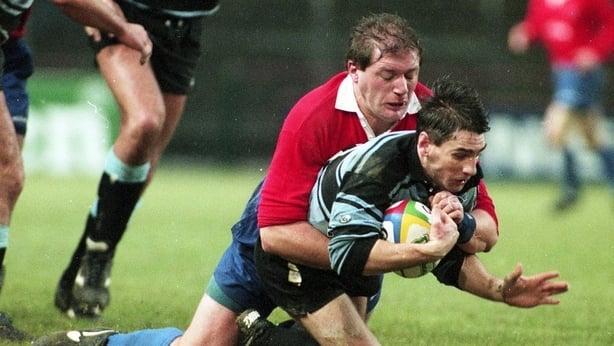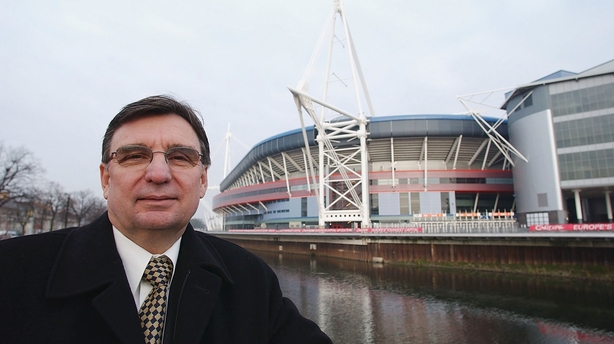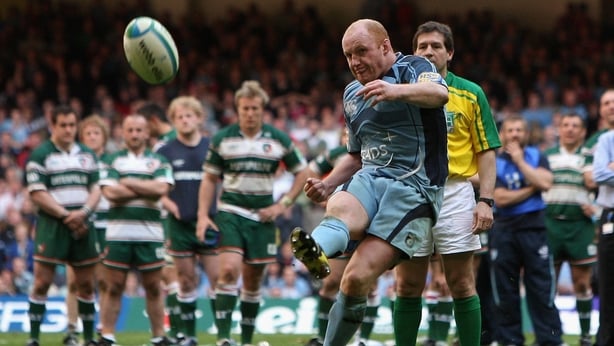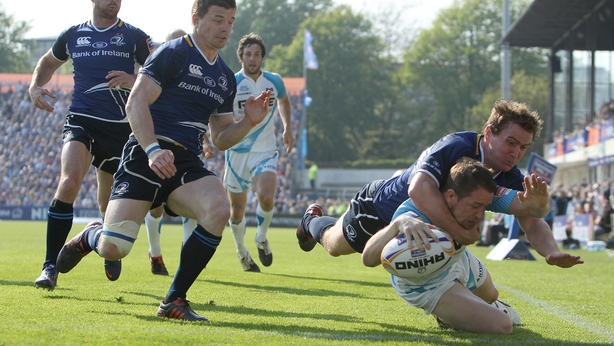Are the Welsh sides about to take a permanent place at the top table of European club rugby?
On Saturday, the 2018 Scarlets side become only the fifth Welsh side to contest a European Cup semi-final in the 21st century and the first since the Cardiff Blues were beaten by Leicester in a penalty shootout in the Millennium Stadium nine years ago.
The great flanker Martyn Williams was the Gareth Southgate/Stuart Pearce figure that day, making a hames of his attempt at a penalty kick in sudden death.
No Welsh side has reached the final of the Heineken/Champions Cup since Cardiff in early 1996 and that was the inaugural event, an inaugural event beset by teething problems.
The 1995-96 campaign was very much the Ford Model T of European Cup competitions – as opposed to the flashy Mercedes that the Heineken Cup later became. We call it a campaign but there were so few games, it could nearly have been run off as a blitz.
The flinty English clubs weren’t standing in the way as they - not for the last time - boycotted the tournament.
Leinster played the first of their two pool games away to Milan in front of about 50 people (a "handful of alickadoos" was winning try scorer Niall Woods' description of the travelling support). After scraping by Pontypridd by a point in their next match, they were in the semi-final.
There, they faced Cardiff in Lansdowne Road in front of 7,000 people in a game played on the second last day of 1995. Dublin 4 was a happy hunting ground for the Welsh even in those bleak years and Cardiff took home the spoils, winning 23-14.
22 years on and the Champions Cup is now a prime time juggernaut. There’ll be no petty asterisks over the achievement should Scarlets reach the final this year.

But the big question is why the Welsh regions have struggled relative to the Irish provinces in the modern era?
At the depressing tail end of the Graham Henry era, a consensus began to form, led by the under-fire coach himself, that Wales was carrying too many professional clubs and needed to develop a regional structure akin to Ireland or New Zealand.
In 2003, the year of Wales’s last whitewash in the Six Nations championship, WRU chief David Moffett announced that the nine existing professional clubs would be re-organised into four regional sides.
After months of protest and angry lobbying by the clubs – most notably Llanelli and Cardiff who managed to remain standalone – it was agreed that five regional sides would be created.
Of the remaining three, Neath and Swansea joined together to form Ospreys, Newport and Ebbw Vale became the Newport Gwent Dragons, and Bridgend and Pontypridd formed the Celtic Warriors.
The Warriors, despite reasonable performances on the pitch, went bankrupt and folded after just one season, leaving them with four again.
For years, the perception in Ireland - accurately or inaccurately - has been that Welsh rugby fans resented the downgrading of their famous community clubs to secondary status and were entirely indifferent towards the fortunes of these 'makey-up' composite entities.
BBC commentator and former Welsh rugby international Eddie Butler said as much in an Irish Independent column back in 2012.
"Deep down, the Welsh still resent the creation of their four professional teams, the Blues, Dragons, Ospreys and Scarlets, colours and creatures that have been painted over the names of the nation’s rugby cities and towns. Spectators are as rare as dragons and ospreys in Wales.
"… Leinster, Munster, Ulster – with Connacht below, the sprung mattress to cushion any fall – were as naturally delivered to the professional game in Ireland, and as wholeheartedly supported by existing fans, as the Welsh regions were cobbled together as quick fix in a time of woe, and ignored by the public."
The perception has also been bolstered by output from the likes of famous Welsh rugby writer Stephen Jones, a man who has been religiously hate-read by rugby supporters on this side of the Irish Sea for the past two decades.
In 2002, Jones described Ireland as the 'smuggest rugby nation' and painted the rugby authorities here as clueless and insular.
He was deemed to be almost provocatively slow in acknowledging the talents of the O'Driscoll generation of Irish rugby players and most weekends, the letters to the editor page contained at least one missive written from an Irish address complaining about Jones and his presence in the paper. At the time of writing, it is estimated that he has blocked about 80% of the population of the island of Ireland on Twitter.
The day after Ireland won the Grand Slam this year, he praised the Irish players, the coach Joe Schmidt, the benefits of the Irish system, and argued that Ireland were serious contenders for the 2019 World Cup.
But he credited the IRFU only with dumb luck. They simply fell back on the organic and longstanding provincial structure which, it transpired, was perfectly suited to the professional game. They didn't have to engage their brains at all, and a good thing that was too, claimed Jones.
"Ireland had the most stupendous stroke of luck when the game went professional and every other rugby nation in the world was trying to work out what to do. Which professional teams to form, what silly names to call them, whether they should be representative of communities, or chunks of the country... Ireland did nothing. There was nothing to be done. They already had four provincial teams, not random chunks of the nation but institutions that had been in existence for donkeys years and before that.
"The other stroke of luck is that given the traditional pace and vision of the Irish Rugby Football Union, the most self-serving and inward of all the major unions, there is no way they would have made the correct call or formed the correct vision in a thousand years had they been called upon to make profound changes."
The unspoken element here obviously was Wales. The inference taken was that it was the Welsh Rugby Union who had to divide their nation into ‘chunks of the country’ and give these new teams ‘silly’ American football style names.

(These names, by the way, have been tinkered with since 2003 and are still a subject of argument and complaint among recalcitrant elements.)
Since 2003-04, only three times have Welsh regions reached the European Cup semi-final - and that's including this year.
In dramatic contrast, the Irish provinces in that period have taken home five Heineken Cup titles, all won during a golden spell between 2006 and 2012, and on only three occasions have the semi-finals not contained at least one Irish side.
In 2016, even David Moffett said his vision for regional rugby in Wales had failed and required a radical re-think. Meanwhile, the likes of Butler and others harked back to the era of Pontypridd, Neath, Bridgend, Swansea et al.
However, the view of well placed sources within Wales is that this is all nostalgic twaddle.
Contrary to popular myth, the crowds attending Pro14 and European clashes in recent years are significantly bigger than those which followed Neath and Swansea during the dying days of the old structure in the late nineties and the early noughties.
The reasons behind the Welsh teams' lack of success of in Europe may be more straightforward.
Namely, lack of funding. The playing budgets available to the Welsh regions are simply not on a par with those available to Leinster, Munster and Ulster, never mind those in France and England.
Unlike Ireland, Wales doesn't employ a central contracting system but a dual system where the WRU pay 60% of the wages of the national team players with the regions themselves stumping up the other 40%. The Welsh clubs have been dependent for a long time on wealthy benefactors like pie magnate Peter Thomas who has pumped millions of his own money into the Cardiff Blues in the past two decades, with no expectation of getting it back.
The overall playing budget of the Blues, Ospreys and Scarlets is around £5 million apiece. It's awkward comparing this figure to individual provinces in Ireland but spending on professional game costs here in 2017 hit €41.1 million and it's generally believed that the likes of Leinster would have more money to play with in terms of playing budgets.
The Welsh pro clubs did enjoy a period of relative prosperity in the late noughties. Llanelli Scarlets (as they were then officially titled) reached the semi-final in 2006-07, having disposed of reigning champions Munster in the quarter-final, and then the Cardiff Blues reached the final four in 2008-09, only falling to the Leicester Tigers in that famous penalty shootout in the Millennium Stadium.

Welsh Pro12 success has been more regular than the popular imagination in Ireland seems to have it. In both 2010 and 2012, Ospreys came to the RDS and beat Leinster in the Pro12 final, with the latter decider being won in especially audacious fashion.
Somehow, both these losses were received as semi-aberrations - despite the fact that the same thing occurred twice in three years. ('Leinster were still hungover after winning the Heineken Cup eight days earlier', people reasoned after 2012.)
Ospreys are currently joint-top with Leinster in the Celtic League/Pro12/Pro14 roll of honour with four wins apiece.
There followed a period of recession era retrenchment as the benefactors pulled back a step. Then the regions and the WRU were sucked into a bitter civil war over funding, with the former alleging an excessive focus on the national team at the expense of the clubs. Wales were winning Six Nations titles at the time but their best players were playing in England and France.
A new dispensation was agreed in 2014 and the Welsh regions appear happier with the new regime at the WRU. The relationship between the national team and the club game has been re-balanced somewhat with the emphasis no longer exclusively on enabling Warren Gatland to win international matches.
The great exodus has been halted and has gone into reverse with Ross Moriarty and George North set to return home. Late last year, Wales introduced Australia's 60-cap rule, specifying that a player needed to have 60 caps under their belt before they could go abroad and remain eligible for international duty.
It's surely no coincidence that Scarlets' scintillating form in 2017 and 2018 has come along since the new arrangement was agreed.
The crowds have flowed back. Sell-out crowds watched Llanelli beat Toulon in the final pool game and another sellout watched them dispatch La Rochelle in the quarter-finals. 15,000 or so supporters from West Wales are expected to arrive in Dublin this weekend.
Any apathy that people might have associated with the Welsh professional club game has probably less to do with purist disdain for these new-fangled outfits and more to do with them continually losing games.

And that, after all, ties in with the experience in Ireland. Stephen Jones and others may slightly overestimate the extent to which Leinster, Munster, Ulster and co were monsters waiting to be unleashed, beloved institutions with a captive and passionate fanbase.
In truth, those wintry inter-provincial encounters between Leinster and Munster attracted pathetic crowds during the 1980s and the early 1990s.
The situation didn't improve too dramatically once European competition was established with Leinster still drawing puny numbers to Donnybrook in the late nineties.
And while Limerick is now regarded as the spiritual as well as physical home of Munster Rugby, the Limerick-born historian and academic Liam O'Callaghan has pointed out there was actually a bubbling undercurrent of hostility towards the Munster concept in the city prior to the professional era. The hostility was based on the assumption - justified or otherwise - that there was a bias towards Cork players of private school background in selection.
That all changed after 2000 when Munster beat Stade Francais and Toulouse en route to the Heineken Cup final. Essentially success arrived and the crowds began to respond.
It was telling that Munster's crowds dipped alarmingly - the late Anthony Foley bemoaned the 7.000 crowd for a game against Ulster - during their difficult 2015-16 season.
Now that the Scarlets are beginning to produce success, could they light the spark which would see the Welsh regions take off like the Irish sides in the noughties?
Follow Leinster v Scarlets via our live blog on RTÉ.ie and the News Now App (kick-off 3.30pm), or hear live updates on RTÉ Radio 1's Saturday Sport. Follow Racing 92 v Munster (kick-off 3.15pm) via our live blog or listen to live and exclusive radio commentary on RTÉ Radio 1's Sunday Sport.


